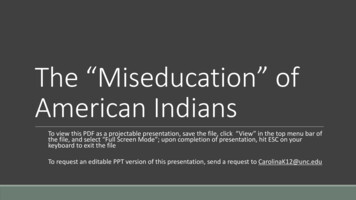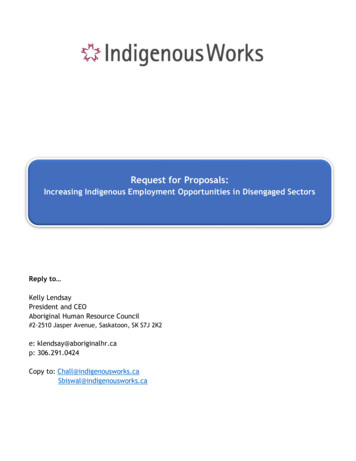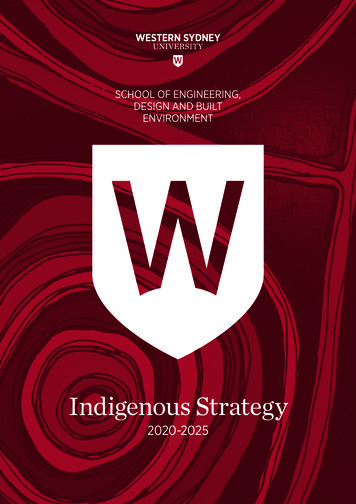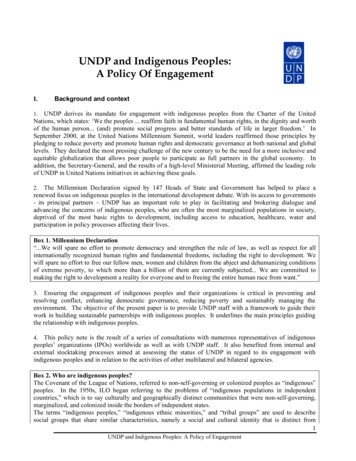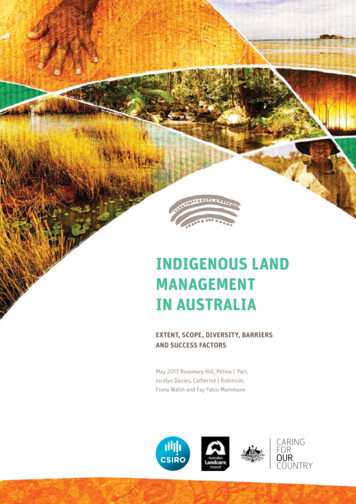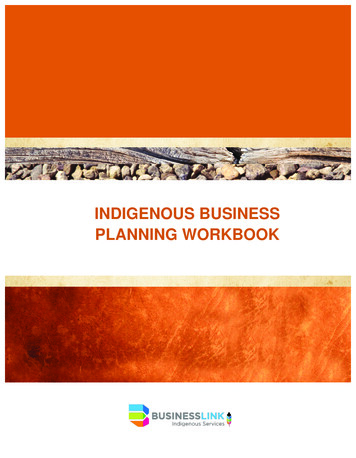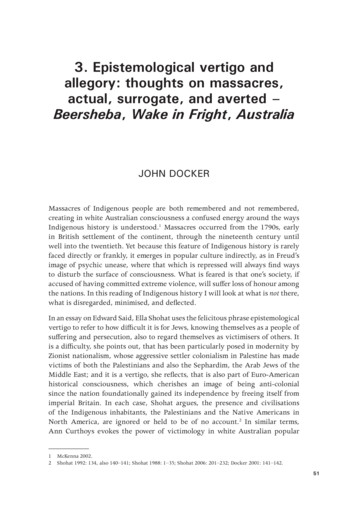
Transcription
The Miseducation of Indigenous People"The white man's superior technology, hunger for land, and ethnocentrism seemingly knew no bounds. Thewhite threat to Indians came in many forms: smallpox, missionaries, Conestoga wagons, barbed wire, andsmoking locomotives. And in the end, it came in the form of schools." -Cornell PewewardyOverviewThroughout history, from American colonization until the mid-1900s, the American government designed andimplemented various “educational” policies designed to assimilate, “Christianize,” and “civilize” indigenouspeoples. With no regard for their varied and rich customs, traditions, values or lives, American Indians weresubjected to numerous failed educational policies, serving as another example of the American government’soppressive failings in regards to indigenous people. In this lesson, students will learn about the history of theeducation, or miseducation, of Native Americans/American Indians, as well as the various ways indigenouspeople have fought back and persevered, through interactive discussion based on an accompanying PowerPoint, the examination of primary sources, and art activities. By interpreting historical facts, photographs,reports, quotes, video clips, and other information, students will glean how the forced assimilation of Nativechildren is an important chapter in understanding the government’s war on indigenous peoples, as well as howthey and their cultures have survived despite such adversity.GradesHigh schoolMaterials The Miseducation of American Indians accompanying Power Point, located available oryofIndianEducationPPT.pdfo To view this PDF as a projectable presentation, save the file, click “View” in the top menu bar of thefile, and select “Full Screen Mode”; upon completion of presentation, hit ESC on your keyboard to exitthe fileo To request an editable PPT version of this presentation, send a request to CarolinaK12@unc.eduo Teacher Note: This Power Point is extensive in terms of providing an overview of American Indianeducation throughout history. Given the complexity of the history covered, it is important that theinformation not be delivered as a lecture, but rather include ample discussion and time for studentsto share their thoughts, process their feelings and ask questions. For ideas on how to make conveyingthe information in the Power Point engaging and interactive, trategies.pdf. Teachers should also determine if/howthey want students to take notes based on what they learn (i.e., Cornell Notes) Unseen Tears: The Native American Boarding School Experience in Western New York:https://www.youtube.com/watch?v ioAzggmes8c (9 minute 9-minuteip) Primary Source Packet – Boarding Schools, attached Quotes for Discussion, attachedEssential Questions What were the various attitudes of Euro-Americans and Americans towards indigenous people fromcolonization through present? What were the various policies of the federal government for educating American Indians? What were the goals and consequences of such policies? What were the purposes, experiences and long-term impacts of Indian boarding schools?1
How did tribal schools and their goals differ from federal schools, policies and goals?What are the various ways Native People have resisted oppressive policies and racist attitudes?What does it say regarding the strength of American Indians that despite all the effort and energy that hasbeen spent on eradicating their culture, Native languages, spiritual practices, and other customs live on?What long-term impacts has the history of the government’s treatment of American Indians had on theireducational attainment and general well-being today?What are some ways people today can work to make a positive difference in terms of righting the wrongsof American Indian abuse and oppression?DurationTwo or more 60-90 minute class periodsTeacher Preparation For this lesson, the terms Native American and American Indian are used interchangeably. It should benoted that while both terms are commonly, some scholars consider both terms to be oppressive. Teachersmay also choose to use the terms indigenous peoples or First Nations, based on their own research andviews, and/or after asking the opinion/preference of any indigenous students in your class. This lesson deals with a disgraceful aspect of American history: the systematic unjust treatment ofindigenous peoples by the American government. Even though addressing such topics can be difficult andeven controversial, it is important for students to explore a comprehensive history. In order to study thishistory effectively and safely however, teachers must have established a safe classroom with clearexpectations of respect, open mindedness, tolerance, and civil conversation. See Carolina K-12’s“Activities” section of the Database of K-12 Resources for strategies to create a classroom environmentconducive to the effective exploration of controversial materials. See also our Tips for Discussing SensitiveHistory & Controversial Current Events.Student Preparation Students should have a basic background knowledge of Native American history, including anunderstanding of Indian Removal, the reservation system and termination. Students should also have an understanding of vocabulary words such as genocide, assimilation,Eurocentric, ethnocentric, and deculturalization.ProcedureDay 1An Introduction to the History of American Indian “Miseducation”1. As a warm-up, project the quote on slide 2 of the accompanying Power Point and instruct students toconsider the passage for a few silent moments:"As a savage, we cannot tolerate him any more than as a half-civilized parasite, wanderer or vagabond.The only alternative left is to fit him by education for civilized life. The Indian, though a simple child ofnature with mental facilities dwarfed and shriveled, while groping his way for generations in thedarkness of barbarism, already sees the importance of education; bewildered by the glare of acivilization above and beyond his comprehension, he is nevertheless seeking to adjust himself to thenew conditions by which he is encompassed. He sees that the knowledge possessed by the white manis necessary for self-preservation.”Discuss: What words or phrases stood out to you when reading this quote? How does the author view and characterize American Indians? What does the author think AmericanIndians need and want? What overall message is this quote conveying? Whose perspective does this statement represent?2
How do you think the author would define being “civilized?” Who or what do you think this sameperson would consider “uncivilized?” Who gets to determine who or what is civilized and who/what isnot?What is your opinion of what the author is saying? How would you characterize the person who wrotethis? If you had the opportunity, what would you like to say to the person who wrote this?In what ways were American Indians the opposite of how this quote describes them? In what ways didEuro-Americans actually exhibit some of the traits attributed to Native Americans in the quote, such asthose of parasites, the exhibition of dwarfed and shriveled mental facilities, and barbarism?2. Explain to students that this quote is a direct phrase from the 12th Annual Report of the Board of IndianCommissioners in 1880. Explain that as soon as Euro-American colonies took root in North America, thequestion of how to “civilize” the indigenous peoples became a focus of the new settlers and the newlyformed American government. Euro-American policy makers struggled with what they considered the“Indian problem” for decades and relied on various “educational” policies throughout history to “civilize”the very people whose land they had invaded. In the end, this became yet another way that IndianAmericas were unjustly exploited by the American government. Let students know they will be learningabout the history of American Indian education (or “miseducation”) in this lesson plan.3. Project slide 3, “Education before 1492,” and point out that it is important to recognize that beforeColumbus even set foot in North America, the people native to the land already had their own educationsystems in place, just as we know they had their own customs, religions, values, traditions, etc.Nonetheless, in each of the colonies, Euro-Americans created a plan for formal Indian schooling thatcentered on Christianizing and civilizing Native Peoples. Share the information on slide 4 and discuss: Why do you think colonists thought they needed to “Christianize and civilize” the Native People? Whywere Native customs, religions and practices not valued? Why do you think colonial attempts to “educate” Natives failed? What do you think “success” would have looked like to colonists?4. Share the information on slide 5 and explain that even though colonial attempts to control Natives thougheducation failed, the goal to “Christianize and civilize” Natives took root in the newly formed Americangovernment. Create two columns on the board, one titled tribal schools and one federal schools. Askstudents to imagine how they think these two types of schools would have differed. Encourage students tovisualize each school type, noting their thoughts in the appropriate column. Solicit student thoughts byasking: What do you imagine the difference was between these two systems of education (tribal andfederal?) How do you think they would have differed in their curriculum, instruction, priorities, etc.? What would a classroom look like in each school? What would students be doing and learning? Whattypes of things might you see and hear? How do you imagine students felt in each type of school?5. Move on to slide 6 and discuss tribal schools: Why do you think Native People wanted to maintain their own school system? According to the quote, why did tribal schools also include teaching Natives the language of theinvaders?6. Go over slide 7 and discuss federal schools: Why do you think religious organizations and churches in particular were provided federal funds torun schools for Natives? How do you think Native People felt attending these schools? What do you imagine they were like? Based on what we’ve just discussed over the last two slides, is there anything you would add to our 2columns regarding the difference in tribal and federal schools?3
7. Move on to slides 8 & 9 and discuss: What impact did removal have on all aspects of Native life, including education? What do you imagine the experience of American Indians was in manual labor schools?American Indian Boarding Schools8. Next, project the images on slide 10 and ask students to comment: What do you see in these images? What first strikes you? What differences do you see in the two pictures? What similarities do you see? (Allow students toshare their preliminary thoughts before giving any information about the image. After a fewminutes, if no one has mentioned it, ensure students note that it is the same young man pictured inboth images.) What do you think brought about such a change in this young man’s appearance? What might hehave experienced to undergo such a transformation?9. Share the quote on slide 11 and ask students to further discuss: What message is being conveyed? Who might have held such a view in the 1800s? What are some of the attempts that we have discussed that were made to “kill the Indian in him?”What other ways might have been employed throughout the 1800s, after the Civilization Fund wasrepealed, to “kill the Indian in him”? How do you think this quote connects to the images you just viewed?10. Move on to slides 12 & 13 and explain to students that even with the repeal of the Civilization Fund, theAmerican government’s goals with Indian education did not change. Let students know that thegovernment transitioned to boarding schools as a means of educating Native People. The quote justdiscussed is attributed to Robert Henry Pratt, who founded the first official boarding school for AmericanIndians in 1879, called the Carlisle Boarding School. Let students know that the images they previouslyviewed are before and after pictures of Tom Torino, a Navajo youth who attended the Carlisle School.Discuss: Given what you have learned thus far, what do you predict happened at boarding schools? What wasprioritized? How were Native Americans treated? What types of things, and in what ways, do youimagine were taught? What types of experiences do you think Tom had?11. Share the details on slide 14 and discuss: Why do you think teaching “work ethic” was so central to boarding school philosophy? Why do you think the government was so afraid of American Indian traditions, customs, ways of life,etc.? What do you imagine it would have been like to be a young child, removed from your family, and sentto such a school, with no choice on your or your family’s part?12. To assist students in further understanding what the experience of boarding schools was like, teachers canplay a short clip (9 minutes) from the documentary, Unseen Tears: The Native American Boarding SchoolExperience in Western New York: https://www.youtube.com/watch?v ioAzggmes8cStart the clip at 1:08 and play it until the end. Let students know the clip will last around 9 minutes andthat it is about the boarding school experience. Instruct students to jot down thoughts, emotions,questions, and other reactions they have while watching the video and listening to survivors. Afterwatching, discuss: The video starts by showing a group of American Indians singing. How would you describe them? Howold do they appear to be? Why do you think they are singing “10 Little Indians?” What is problematicabout seemingly innocent songs like this? According to Michael Martin, what was the first goal of the government, before deciding to “kill theIndian and save the man?” What was the idea behind this policy?4
Throughout the video, we meet several American Indians who went to boarding schools. What varioushardships and cruelties do they recount? (i.e., poor living conditions inclusive of lice and rats;appearances forcibly changed, such as through shaving their heads and required uniforms; cruelpunishments, such as being locked in dark rooms, having their mouths washed out with soap, coldshowers, beatings; separation from family; forbidden to speak Native languages; etc.) How didboarding schools get by with this?As we saw in the beginning, many students were as young as 4 or 5 years old. Imagine being separatedfrom your family and taken to a strange place at this age, or at any age as a child. What would behardest about this?Summarize the experience Geronimo Henry had when being left as a young boy at the school (5:46).He may feel his mother had forgotten him, but for what other reasons might parents have stayed awayfrom the schools?Why does Geronimo say he didn’t become angry about having been put into a boarding school untilafter he got out (4:00)?What does it say about the Native Americans in this video (and the thousands of others) who not onlysurvived this experience, but are now willing to share their experiences? What would be difficult aboutremembering these events for them?Throughout the clip, we see a few excerpts of a black and white film (2:20; 7:04; 8:57) with agovernment official describing boarding schools. What type of information does he share? How doesthis information differ from what the surviving students say? What do you think the purpose of thisfilm was/what was it used for? (Discuss the concept of government propaganda with students.)At the start of the clip, (2:35) Michael Martin notes of boarding schools and related history, “This nevermakes it into the history books; this is never talked about.” Why do you think this is the case? Why is itimportant that everyone know this history, even though it might be shameful and hurtful?Are there other historical events this history reminds you of? (Students might connect this to topicssuch as the Holocaust, Japanese Internment, the Jim Crow Era, etc.)Exploring Boarding Schools through Primary Sources13. Tell students they are going to explore and discuss boarding schools further in small groups. Assign (orallow students to choose) groups of 3-5 and provide students with the attached Primary Source Packet onboarding schools. Students should review each source together, discussing the corresponding questions.After students have had ample time to review the sources and discuss the questions, debrief the materialsas a class. In particular, have each group summarize their response to question V with the class. (Ifadditional time is needed, this activity can also be assigned or finished the next time class meets.)Teacher Notes/Options: Teachers may want to copy a class set of the Primary Source Packet and instruct students not to writeon the packet. This will allow the same packets to be used across various classes. If desired, students can complete this activity individually, rather than in groups, by answering thequestions in writing on notebook paper. If time does not permit for working on the packet in class, students can also be given the packet tocomplete for homework. To make the activity shorter, teachers can omit sources to be reviewed, or questions to be answered,as needed.5
Day 214. As a warm-up and reminder of the previous lesson, project slide 15 andinstruct students to design a resistance t-shirt that addresses what theyhave learned thus far regarding the history of American Indian miseducationin some way. Provide art paper and colored pencils and instruct students tohang their t-shirt designs around the room once finished. (Provide around 8minutes.) Teachers can then give each student a Post-It Note and provide afew minutes for students to circulate around the designs, sticking their PostIt by the design they like the most. Use the completed t-shirt designs as abasis for a review discussion of material covered previously.15. Return to the Power Point at slide 16 and discuss: Why did boarding schools fail? What does it say regarding the strength of American Indians that despite all the effort and energy thatwas spent on eradicating their culture, Native languages, spiritual practices, and other customs livedon? In 1906, the government decided to start shifting American Indians into the public-school system.What were schools in North Carolina like in the early to mid-1900s? What do you already know aboutthis time period, referred to as the Jim Crow Era? With segregation in full effect, where do you think American Indians were expected to go to school?What experience do you think they had in public schools during this period of Jim Crow andsegregation? What impact do you think experiencing racism and prejudice throughout this time had on theeducation of Native People in public schools?The Fight for Civil Rights16. Move on to slide 17 and 18 and discuss: Why do you think it took so long for attention to be paid to the terrible aspects of boarding schoolsand the government’s policies regarding American Indian education? The report called for a child-centered, culturally appropriate education for Native People. Do youthink they would get this in public schools in the 1900s? Why or why not? Where could they receivean education like this? Why do you think the Meriam Report said that what was most needed in Indian education was a“change in government attitude”? What changes in thinking begin to become more prominent with John Collier’s Indian New Deal? (i.e.,free the Indian from government control as opposed to “kill the Indian, save the man”)17. Go thorough slides 19-21 and discuss: Why do you think American Indian civil rights leaders stressed an agenda of “self- determination?” It is important to note that throughout history, even with so much stacked against them, NativePeoples have done their best to stand up for their rights to the best of their ability. What does such awill to fight and move forward in the face of such adversity say about a people? It is very easy to giveup fighting and surrender (physically, emotionally, psychologically, etc.) What has kept so many NativePeople from doing just this? What difference did the actions of civil rights activists, Native and non-Native, make? Why is itimportant to be civically active in his way and stand up for your rights and beliefs, even if, andespecially if, others are constantly trampling on those rights and beliefs? What are the benefits of tribally controlled schools? How are tribally controlled schools, such as the Haliwa-Saponi Tribal School, different than boardingschools?6
Why do you think the Education Act of 1975 specifically advocated for parent involvement in programplanning, for the establishment of community-run schools, and for culturally relevant and bilingualcurriculum materials? Why are these things so important?A Lasting Impact on American Indian Youth18. Share the information on slides 22-24 and discuss: Why do you think the statistics regarding the education of American Indian children are so negative? Who/what is at fault for low achievement rates and high dropout rates? (Have students discuss thevarious aspects of history that have contributed to this, as well as discussing how the issues noted –poor teaching, Eurocentric curriculums, limited access to multicultural curriculum, etc. – also play apart.) What does it mean when we say that centuries of racism, genocide and assimilationist polices cannotbe undone in a matter of years?o Teachers might choose to use a race analogy with students. If everyone lines up at the startingline for a race, but for no reason, a certain group of people are forced to start one mile behindthe starting line, the majority of those people will have trouble catching up to those whostarted at the rightful beginning of the race. Some will catch up, but likely due to workingextremely hard, or perhaps even having some type of luck involved. The point is that it’s unjustthat the race is rigged in this way. Are you surprised to hear that overall, Indian youth (12-17 yrs.) engaging in drug and alcohol use ishigher than the national average? Why do you think this is the case? Native leaders see a direction for how to improve student achievement and academic prosperity,including through the preservation of tribal cultures and languages. Do you agree this will help?What else is needed, in your opinion?19. Share slide 25 and discuss: According to the quote, why is a Treaty of 1992 needed? What do you think the authors would argueneeds to be included in such a treaty? What do you think should be included? Why do you think leaders believe that change will only occur when Native and nonnative societiesmake the commitment to work together? Do you agree? What might be difficult about this type ofcollaboration? (i.e., mistrust based on historical realities)20. To begin a culminating discussion, have students gather into groups of 4-5 and provide each group withone of the attached quotes. Project slide 26 which contains guiding questions for groups to answer. Tellstudents to be prepared to share with the remainder of class. Once students have had 5-7 minutes to talkin groups, bring the class back together, project the quotes on slide 27, and have students report outregarding their discussions. Further discuss: We’ve discussed how boarding schools were used in an attempt to force American Indians toassimilate into the “mainstream” culture. Can you think of moments throughout history, or in currentevents, when education has been used in similar ways with other groups? Now that you are educated on the history of American Indian education (or miseducation), what areyou left thinking or feeling? It is understandable to be angry regarding history such as this. While the government has madeprogress, and while society may be more accepting today of differences, we still have far to go. Whatare some ways emotions such as anger can be channeled productively to make a difference andensure things continue to improve? Some people may feel like it’s not worth even bothering tochange anything, when so much is stacked against them. Why is allowing anger, hate and apathy totake over dangerous? Remember that throughout history, even with so much stacked against them, Native Peoples havedone their best to stand up for their rights. What does such a will to fight and move forward in theface of such adversity say about a people? It is often easier to just give up; why is it crucial to not dothis?7
What are some ways you can make a positive difference in terms of righting the wrongs of AmericanIndian abuse?Culminating Assignment: The Legacy of American Indian Education21. As a culminating activity, have students examine the historical marker for the Carlisle Indian School,located on slide 28. Discuss: Have you seen markers such at this at various historic sites? Is this an effective way to educatepasserby’s regarding the history of a place? Why or why not? Do you feel this sign and its text does justice to telling the history of the Carlisle School? Why or whynot? What is included? What is left out? What (if anything) is misleading? How should this aspect of history be told and properly remembered? If you were asked to redo thissign, or think of another way to educate people regarding the Carlisle School, or the history ofAmerican Indian education in general, what ideas would you pose?22. Tell students to imagine that they have been tasked with designing a new historical monument or markerthat relates to what they have learned about the history of American Indian education/miseducation insome way. They can create their design on paper (i.e., a blueprint of what their memorial/marker wouldactually look like); in 3-D form using clay, wire, cardboard, etc.; with a computer; or in any creative waydesired. The final project can be literal or abstract, but must relate to American Indian education in someway. For example, final projects might: Tell a true and comprehensive history regarding the education/miseducation of Native People Focus on one particular aspect of what we have learned (such as boarding schools in general, on oneparticular boarding school, tribal schools, etc.) or focus on the general history via a more thematicdesign Focus on the resilience and resistance efforts of American Indians Honor the memory of the American Indians who experienced miseducation Offer inspiration for Native and nonnative societies to make the commitment to work togetherregarding the education of American Indians today Heal wounds and work towards reconciliation; foster hope by envisioning an inclusive societyTeachers should determine how long they will provide for students to work on this in class and/or forhomework. Let students know when their final project is due in class, as well as how they will bepresenting it. (For example, students might post/set up their work around the classroom on the due date.Teachers can give students time to freely rotate among the designs then hold a vote where the classdetermines which memorial/marker most impacted them.)8
Group Members:Primary Source Packet – Boarding SchoolsI.Quotes: Read each quote and discuss the questions that follow.“I do not believe that Indians people who for the most part speak no English, live in squalor anddegradation, make little progress from year to year, who are a perpetual source of expense to thegovernment and a constant menace to thousands of their white neighbors, a hindrance to civilizationand a clog on our progress have any right to forcibly keep their children out of school to grow up likethemselves, a race of barbarians and semi-savages.” T.J. Morgan, Commissioner of Indian Affairs, 188918931)2)3)How does T.J. Morgan view Native People?What argument does he make for boarding schools?If you had the change to argue against the ridiculous points made by Morgan, what are threethings you would point out to him?"If the Great Spirit had desired me to be a white man he would have made me so in the first place. Heput in your heart certain wishes and plans; in my heart he put other and different desires. Each man isgood in the sight of the Great Spirit. It is not necessary, that eagles should be crows."Sitting Bull (Teton Sioux)4)5)What message is Sitting Bull sending with this statement?How would Sitting Bull respond to T.J. Morgan regarding whether Native People shouldattend boarding schools?"They told us that Indian ways were bad. They said we must get ‘civilized’ .It means ‘be like thewhite man’ And the books told how bad the Indians had been to the white men—burning theirtowns and killing their women and children. But I had seen white men do that to Indians. We allwore white man's clothes and ate white man's food and went to white man's churches and spokewhite man's talk. And so after a while we also began to say Indians were bad. We laughed at our ownpeople ” Sun Elk, Taos Pueblo, a student at Carlisle Boarding School, 18906)7)8)9)How would you describe the “education” Sun Elk received at Carlisle Boarding School?Why did Sun Elk and his classmates begin to say that Indians were bad and laugh at their ownpeople?What hypocrisy does Sun Elk point out regarding white men? In what additional ways areboarding schools and the government’s justification of such hypocritical?What would Sun Elk and others need after leaving Carlisle in order to rightfully respect theirheritage?9
II.Before and After Photos of Students at the Carlisle Indian SchoolApache children when they arrived at theCarlisle school in 1886: Hugh Chee, BishopEatennah, Ernest Hogee, Humphrey Escharzay,Samson Noran, Basil Ekarden, Clement Seanilzay,Beatrice Kiahtel, Janette Pahgostatum, Margaret Y.Nadasthilah, Fred'k Eskelsejah.4 months later: Samson Noran, Fr
The Miseducation of Indigenous People "The white man's superior technology, hunger for land, and ethnocentrism seemingly knew no bounds. The white threat to Indians came in many forms: smallpox, missionaries, Conestoga wagons, barbed wire, and smoking locomotives. And in the end, it came in the form of schools." -Cornell Pewewardy Overview


